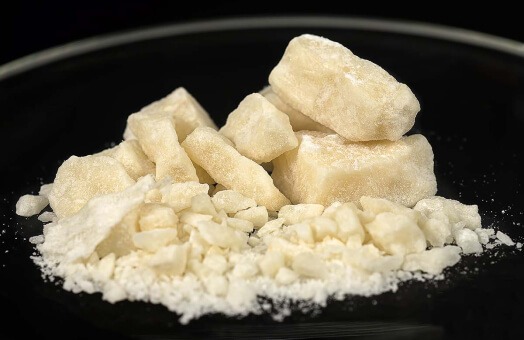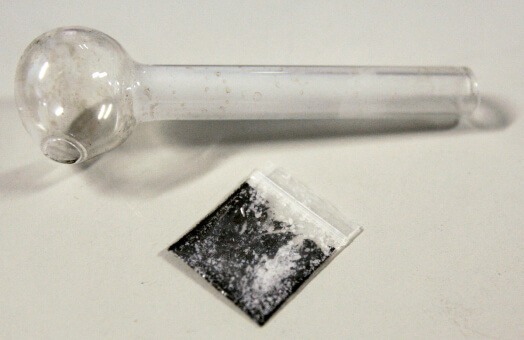Cocaine is a highly addictive stimulant drug derived from the dried leaves of the South American coca plant. Crack cocaine is derived from powdered cocaine in a simple conversion process that makes it easier to smoke.
While crack and cocaine share similar pharmacological properties, they differ in their form, method of use, and onset and intensity of effects. They’re both Schedule II controlled substances and highly addictive stimulant drugs that produce similar psychoactive effects, but there are some important differences to consider.[1]
Key Points
- Cocaine, in its powder or crack form, is a highly addictive stimulant drug.
- Cocaine and crack cocaine produce similar effects, but their method of use, risks, and effects can differ.
- Crack is known to produce a fast-acting, intense high as a result of being smoked rather than inhaled.
- Powder cocaine can produce an equally intense euphoria when it’s injected.
- Both crack and powder cocaine have a high abuse and addiction potential.
Crack Cocaine vs. Powder Cocaine: Similarities
Crack cocaine and powder cocaine produce a potent stimulant and euphoric effect. The effects of crack are more immediate and stronger than cocaine due to the method of administration and the form itself, which allows for faster absorption into the bloodstream.[2]
Both cocaine and crack affect the release of dopamine, serotonin, and norepinephrine, neurotransmitters that influence mental behavioral patterns and movement and inhibit their reuptake.[3] The neurotransmitters build up in the brain, rather than being reused or modulated, and produce euphoria.
The effects of cocaine appear almost immediately after a single dose, but they’re short-lived. These effects include:
- Euphoria
- High energy
- Talkativeness
- Alertness
- Hypersensitivity to sight, sound, and touch
- Lack of appetite
- Insomnia
- Paranoia
- Panic
- Irritability
- Anxiety[4]
The physiological effects may include:
- Dilated pupils
- Constricted blood vessels
- Hyperthermia (high body temperature)
- Increased heart rate
- Hypertension (high blood pressure)[5]
How Is Cocaine Produced?
Cocaine is a byproduct of the leaves of coca plants that grow in South America. People in South America have been chewing and ingesting coca leaves for the stimulant effect for millennia.
Cocaine hydrochloride, the purified chemical form of cocaine, was isolated from the plant over a century ago and used in tonics and elixirs. Cocaine was also used as a numbing agent before local anesthetic was developed.[6]
Though cocaine is still used for some medical purposes, it’s primarily consumed as a recreational drug for its intense euphoric effects. Cocaine is usually sold as a fine white powder that can be snorted or dissolved in water and injected.[7]
How Is Crack Cocaine Produced?
Crack cocaine is a solid free-base form of cocaine that gets its name from the crackling sound the rock makes when it’s heated.[8] Cocaine powder can be converted into crack cocaine by mixing it with water and baking soda and then heating it to get a solid form, which is dried and broken into smaller pieces.
Crack cocaine comes in white or off-white rock crystals that are smoked to inhale the vapors into the lungs, usually with a pipe. Smoking crack has faster-acting euphoric effects, which led to its popularity.
In the 1980s, the Anti-Drug Abuse Act differentiated crack from other forms of cocaine and instituted harsh legal consequences for possession and use of the drug.[9]
Crack vs. Cocaine: Differences
Though crack and powder cocaine are different forms of the same substance, there are some differences in the way they’re used, their effects, and their risks.
-
00 01
Chemical Form
Crack and cocaine share similar pharmacological properties, but they differ in their chemical forms and how they act on the body.[10]
Powder cocaine (cocaine hydrochloride) is a water-soluble hydrochloride salt that can be snorted or injected. In contrast, crack cocaine is a water-insoluble cocaine base – or freebase – that’s made using a simple conversion process to “free the base” and make it “smokable.”
-
00 02
Method of Use
Powder cocaine is usually snorted, but it may be dissolved in water and injected for a more intense high with a more rapid onset of effects. It can also be absorbed through the gums. Crack cocaine is usually smoked, producing a euphoric rush from the vapors.
Studies have found that smoking or injecting cocaine is more likely to lead to addiction and cause more severe consequences compared to simply snorting it.[11] Powder cocaine that’s snorted or absorbed takes more time to reach the bloodstream. Therefore, it takes longer for the euphoric effects to begin, but they last longer.
Cocaine is a potent psychostimulant, regardless of the method to use it – whether snorted, smoked, or dissolved. It is also highly addictive and can lead to more serious issues.[12]
-
00 03
Health Effects and Risks
In either form, cocaine is a potent central nervous system stimulant that carries risks with both short- and long-term use. Over time, cocaine use can result in significant neurological and cardiovascular effects and organ damage – no matter if it’s snorted, smoked, or injected.
There are additional risks based on the method of use. Smoking crack cocaine can cause respiratory issues like asthma and lung damage, while snorting can damage the nasal passages and cause nosebleeds or anosmia (loss of smell). Injecting cocaine may damage the veins and increase the risks of infection and diseases like HIV or hepatitis C.
Though dependence may be more likely with fast-acting methods like smoking and injecting, using cocaine chronically can lead to tolerance, addiction, and overdose.
Cocaine Addiction and Treatment
Cocaine addiction is classified as a stimulant use disorder in the Diagnostic and Statistical Manual of Mental Disorders, Fifth Edition (DSM-5). The criteria include:
- Using cocaine for longer periods or in larger amounts than intended
- Trying and failing to cut down or stop using cocaine
- Spending a lot of time sourcing, using, or recovering from cocaine
- Experiencing intense cravings for cocaine
- Experiencing problems at work, home, or school because of cocaine use
- Continuing to use cocaine despite problems
- Using cocaine despite physical or mental health effects
- Developing a tolerance for cocaine
- Experiencing withdrawal symptoms from stopping or cutting back on cocaine use[13]
Treatment for Cocaine Addiction
Though stimulant use disorders like cocaine addiction can be devastating, treatment is available. Like other substance use disorder treatment programs, cocaine addiction is treated with an individualized care plan that may include:
Medical Detox
Cocaine withdrawal can be extremely unpleasant, but it’s not usually life-threatening. Medical detox provides medication to manage withdrawal symptoms like insomnia and anxiety, as well as medical staff to keep you safe and comfortable as the drug clears your system.
Inpatient Treatment
Inpatient treatment programs provide 24/7 care in a hospital or residential setting. They have a comprehensive care team and treatment options like individual and group counseling.
Traditional therapies like counseling and peer support groups are effective for cocaine addiction treatment, and behavioral therapies are often integral components of the program.[14] Cognitive behavioral therapy and contingency management are designed to address the behaviors that contribute to cocaine use and addiction to provide a long-term strategy for abstinence.
Frequently Asked Questions
Is Crack More Addictive Than Cocaine?
All forms and methods of using cocaine are addictive, but smoking crack may carry a higher risk of abuse because of its rapid, intense high that fades quickly.[15] This requires more of the drug to produce euphoric effects, leading to repeated use. Injecting the powdered form of cocaine dissolved in water also carries a higher addictive potential.
Why Is Crack Punished More Harshly Than Cocaine?
Cocaine is a Schedule II substance under the Controlled Substances Act (CSA). It’s only legal for its limited medical applications, but manufacturing, distributing, dispensing, or possessing cocaine is illegal.
Crack and cocaine used to have similar legal penalties, but the CSA was revised in 1986 to impose harsher penalties for crack than cocaine in response to the “crack epidemic.” As a result, the amount of powder cocaine and crack cocaine required for the minimum sentence was a ratio of 100 to 1.[16]
This was revised in 2010 with the Fair Sentencing Act that reduced penalties to a 10-to-1 ratio for crack to powder cocaine.[17] Then, the First Step Act of 2018 eliminated the statutory mandatory minimum sentence for simple possession of crack cocaine.[18]
Drug fact sheet: Cocaine – dea.gov. (n.d.-b). Retrieved from https://www.dea.gov/sites/default/files/2020-06/Cocaine-2020_1.pdf on 2023, June 28.
Hatsukami, D.K., Fischman, M.W. (n.d.). Crack cocaine and cocaine hydrochloride. are the differences myth or reality?. JAMA. Retrieved from https://pubmed.ncbi.nlm.nih.gov/8918856/ on 2023, June 28.
Cocaine Hydrochloride. Cocaine Hydrochloride – an overview | ScienceDirect Topics. (n.d.). Retrieved from https://www.sciencedirect.com/topics/chemistry/cocaine-hydrochloride on 2023, June 28.
Cocaine | National Institute on Drug Abuse. (2024, April 4). National Institute on Drug Abuse. Retrieved from https://nida.nih.gov/research-topics/cocaine#short-term on 2024, June 21.
Cocaine | National Institute on Drug Abuse. (2024, April 4). National Institute on Drug Abuse. Retrieved from https://nida.nih.gov/research-topics/cocaine#short-term on 2024, June 21.
U.S. Department of Health and Human Services. (2022, May 2). What is cocaine?. National Institutes of Health. Retrieved from https://nida.nih.gov/publications/research-reports/cocaine/what-cocaine on 2023, June 28.
Powdered cocaine fast facts. (n.d.). Retrieved from https://www.justice.gov/archive/ndic/pubs3/3951/index.htm on 2023, June 28.
Crack Cocaine Fast Facts. (n.d.-a). Retrieved from https://www.justice.gov/archive/ndic/pubs3/3978/index.htm on 2023, June 28.
Crack Cocaine Fast Facts. (n.d.-a). Retrieved from https://www.justice.gov/archive/ndic/pubs3/3978/index.htm on 2023, June 28.
Crack cocaine and cocaine hydrochloride. Are the differences myth or reality? (1996, November 20). PubMed. Retrieved from https://pubmed.ncbi.nlm.nih.gov/8918856/ on 2024, june 21.
Crack cocaine and cocaine hydrochloride. Are the differences myth or reality? (1996, November 20). PubMed. Retrieved from https://pubmed.ncbi.nlm.nih.gov/8918856/ on 2024, June 21.
Stimulant overdose. (2024, May 8). Overdose Prevention. Retrieved from https://www.cdc.gov/overdose-prevention/about/stimulant-overdose.html on 2024, June 21.
Stimulant use disorder. PsychDB. (2022, November 30). Retrieved from https://www.psychdb.com/addictions/stimulants/1-use-disorder on 2023, June 28.
McHugh, R. K., Hearon, B. A., & Otto, M. W. (2010). Cognitive Behavioral therapy for substance use disorders. Psychiatric Clinics of North America/the Psychiatric Clinics of North America, 33(3), 511–525. Retrieved from https://www.ncbi.nlm.nih.gov/pmc/articles/PMC2897895/ on 2024, June 21.
Hatsukami, D.K., Fischman, M.W. (n.d.). Crack cocaine and cocaine hydrochloride. are the differences myth or reality?. JAMA. Retrieved from https://pubmed.ncbi.nlm.nih.gov/8918856/ on 2023, June 28.
Crack cocaine offenses and the First Step Act of 2018: Overview and Implications of Terry v the United States. (n.d.-a). Retrieved from https://crsreports.congress.gov/product/pdf/LSB/LSB10611 on 2023, June 28.
Crack cocaine offenses and the First Step Act of 2018: Overview and Implications of Terry v the United States. (n.d.-a). Retrieved from https://crsreports.congress.gov/product/pdf/LSB/LSB10611 on 2023, June 28.
Crack cocaine offenses and the First Step Act of 2018: Overview and Implications of Terry v the United States. (n.d.-a). Retrieved from https://crsreports.congress.gov/product/pdf/LSB/LSB10611 on 2023, June 28.



